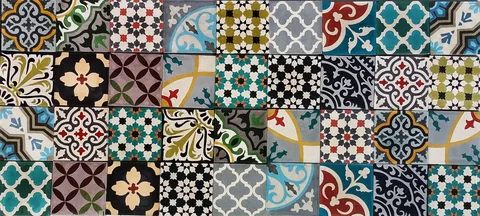The phrase “Everything old is new again” has been attributed to everyone from Mark Twain to Winston Churchill, but this old-fashioned tile type proves the point. From the thirteenth century encaustic tiles, also known as Mosaics Hidralicos, were used to liven up floors throughout Europe. The cement-based tiles – which feature classic geometric shapes, simple flowers and stars – aren’t just a throwback to the past; their durability and striking designs make them perfectly at home in today’s homes.
A resurgence in interest in artisan-made products means that true cement encaustic tiles are easy to find, but as with all things it’s best to shop smart. Not all encaustic tiles are created equal; the quality of the tile, and how the pattern is printed on it, will significantly impact the finished product and its longevity.
Unlike ceramic or porcelain tiles, encaustic tiles aren’t fired in a kiln. They are made from a combination of materials, including a base layer of cement, crushed marble, and sand, with a 2/3mm top layer of plaster or cement which features the design or colour. The whole is hydraulically pressed so the design is ‘impregnated’ into the tile. This process ensures that the design won’t fade, scratch or crack.
Encaustic tiles were popular in the Middle Ages and phased out around 1600, but the style was revived during the Gothic Revival era of the eighteenth and nineteenth centuries. In fact, a visit to some of the older buildings in England will show you many fine examples of the classic encaustic pattern that was so popular.
The most important thing to remember when working with these beautiful tiles is that they need to be sealed properly, as they are very porous. It’s vital that you seal the encaustic tiles as soon as they are installed, and continue to re-seal them regularly to prevent them from becoming stained or discoloured. A water-based sealer such as Ultracare Penetrating SB Stone, Tile & Grout Sealer will be suitable.
While encaustic tiles are available in an extensive range of patterns, it’s best to stick with just one or two colours at a time. Too many different coloured or patterned tiles can overwhelm a room, and it’s also crucial to think about the surrounding materials, finishes and colour palette.
If you’re considering using encaustic tiles in your bathroom, Marish recommends pairing them with a plain or textured wall tile to keep the overall look clean and classic. “This will provide a balance of texture and pattern that’s very European,” she says.
Kitchen splashbacks are another great place to use a patterned tile, as they are less likely to compete with other elements of the room. But Marish recommends taking your cues from the overall kitchen colour scheme to create a coordinated look. “The tile colours need to reflect the colours in the cabinetry, benchtops, tapware and the colour of the walls,” she says. “And of course the overall colour and design of the space.” If you’re after a more relaxed feel, then encaustic tiles work beautifully in outdoor areas such as the patio or garden where they will blend with the natural environment and be exposed to the elements.
